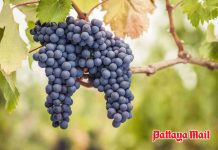There’s an old joke that to make a small fortune in wine, start with a big one. Joseph Helfrich was an exception, for in 1979 he was virtually broke. His father’s business had been rapidly going downhill and eventually went bankrupt. But with a modest investment, the 23-year-old Joseph decided to start selling wine. Today – about thirty years later, he sells more than sixty four million bottles every year in 160 different countries. The once-penniless Joseph Helfrich is now the owner and president of Les Grands Chais de France – the largest wine exporter in the country. If that’s not a resounding success story, I don’t know what is.
Joseph Helfrich chose to be different from the outset. He wanted his wines to be simple and appealing; something entirely different to the traditional wines of Bordeaux with their complicated and rule-governed appellation system. Single-handedly he created J. P. Chenet as “a brand for the masses” (his own words, evidently) in 1984.
 Even the Chenet factory has unusual contours.
Even the Chenet factory has unusual contours.
He even designed the distinctive bottles. You’ve probably seen them before; those rustic looking things with a dent in the body and a neck that leans to one side like an inquisitive dog. For reasons which are not entirely obvious, he named the bottle a “Joséphine” but it did what he wanted and set his wines visually apart. The bottle presented something of a challenge, because it needed specially-designed bottling equipment. To distance itself even further from convention, the company sold its wines by grape variety rather than by appellation, thus making the label much more user-friendly for the export market.
I suppose it’s easy for wine enthusiasts to be a bit sniffy about commercial crowd-pleasers, but we’ve all got to start somewhere and it would be satisfying to think that some people might eventually move on from easy-drinkers to more challenging wines.
J. P. Chenet Chardonnay (white), France (Bt. 490 @ Friendship and others)
This is a bright gold wine with greenish flecks and a pleasing “tropical fruits” aroma of pineapple and citrus. You might detect the smell of fresh green apples too, and if you’re a good sniffer, a faint background smell of herbs – dill, I think. But you know, this is not the kind of wine to pontificate about, for it’s a basic mass-produced wine, even though it’s a good one. The mouth feel is very soft and seductive with only the tiniest touch of acidity. There’s plenty of fresh fruit on the palate and a longish fruity finish with citrus overtones. The wine is almost totally dry, but not quite.
So if you prefer your whites easy on the palate and not very demanding, you’ll probably enjoy this easy glugger from France. Exactly where in France we don’t know, because the label simply says “Vin de France” so that’s a clear give-away that this wine is a blend of grapes from different sources. The wines in the blend are probably from different years too, because there’s no vintage year on the bottle. “And does it matter?” I hear you ask. Well, for commercial wines like this which are blended for consistency from year to year no, it doesn’t. The quality of the grapes and the skills of the winemaker are probably more important.
Actually, the “Vin de France” designation is relatively new. It replaces the older “Vin de Table” which was used, without putting too fine a point on it, for everyday French plonk. The wines laws of France prevented these ordinary wines from rising above their lowly station by forbidding them to show the grape variety or the vintage year, even if there was one. As a result, Vin de Table wines often suffered in the competitive export market. The new Vin de France category has been in use since 2010 and the wines are usually sold either under a brand name or like this one, a branded varietal.
The wine is quite fun to drink on its own, though it would make a good partner for light snacks such as chicken salad or mild fish dishes. Whatever you do, serve it as cold as possible. The label suggests a serving temperature of 8° -10° which would be about right in cooler countries. But in our tropical paradise, you can serve it straight out of the fridge (at between 1° and 3° C). This lower temperature will “firm up” the wine giving a bit more ‘edge” to the flavour. In any case, once the wine is poured, it’ll warm up only too quickly.
J. P. Chenet Cabernet – Syrah, Pays d’Oc (red), France (Bt. 490 @ Friendship and others)
At first sniff, this very dark red wine reminds me more as a Syrah than a Cabernet Sauvignon. At least, I presume it’s a Cabernet Sauvignon. It could possibly be a Cabernet Franc for the label simply says “Cabernet”. There are aromas of black fruits, rustic herbs, pepper, a hint of sweet blackberries and a touch of spice. It’s a dryish sort of wine with a very smooth mouth-feel and plenty of ripe black fruit and soft ripe tannins with the Syrah bringing out a spicy, peppery flavour. There’s virtually no acidity and the wine has a long and pleasantly dry finish.
At 13% alcohol, this makes an attractive easy drinker and basically, it’s what it says on the label – a southern country wine. If you like smooth, undemanding reds that are not toe-curlingly dry and tannic; you may well enjoy this wine with simple foods and snacks. It really does need a bit of air to bring out the aromas and the taste, so open the bottle in advance. Even so, I’d suggest that you serve it on the cool side at around 14°C. Ideally, tip the whole lot into a cold decanter, especially if you don’t want your guests to be unduly distracted by the Joséphine.




